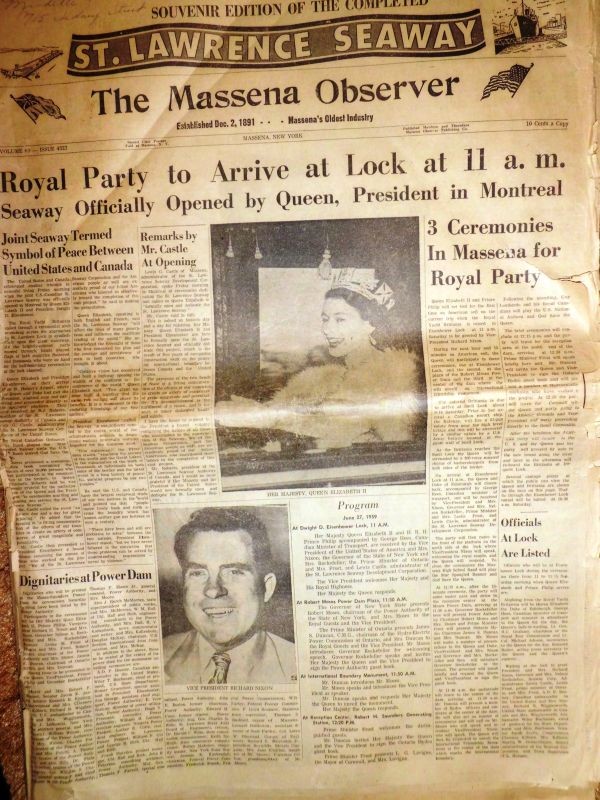SEAWAY @ 55: Economic Potential May Finally Arise Renewed From Great Lakes
|
||||||||||
| Printer Friendly Story View |

Historic souvenir copy of the Massena, New York, Observer from 1959 was saved by Michelle Marie Poirier of Bay City.

Betty Sutton, new U.S. administrator of the St. Lawrence Seaway Corporation, is a former Member of Congress from Ohio.
When did the Port of Bay City-Saginaw become an international waterway?
June 26, 1959, to be precise.
Next year the St. Lawrence Seaway will celebrate 55 years of operation.
In a ceremony presided over by U.S. President Dwight D. Eisenhower and Queen Elizabeth II, the St. Lawrence Seaway was officially opened, creating a navigational channel from the Atlantic Ocean to all the Great Lakes.
Due to its four sections, deep waters and many locks, the Canadian Encyclopedia describes the St. Lawrence Seaway as a "monumental engineering and construction feat."
The St. Lawrence Seaway has tamed the St. Lawrence River, enabling ships to sail from Lake Ontario to the Atlantic Ocean. The resulting deep draft navigation system is the longest in the world, extending 3,700 kilometers (2,300 miles) into the North American heartland.
The seaway, made up of a system of canals, locks, and dredged waterways extends from the Atlantic Ocean through the Gulf of St. Lawrence to Duluth, Minnesota, on Lake Superior.
Unfortunately, notes Paul Sargent, the opening of the Seaway also introduced such invasive species as the zebra and quagga mussel, the spiny and fishhook water fleas, the round goby, and many other destructive, non-native plants and animals hitching rides in the ballast waters of ocean-going vessels that traveled to North American waterways from ports across the Atlantic.
New Seaway Administrator Betty S. Sutton says "there's no confirmed invasive species having come in since 2006, but there's no doubt that it has been a problem in the past," she said. "So I don't see a conflict, frankly. We have a mandate and a mission to keep the Seaway moving safe and efficiently, but we also have a responsibility to do that in an environmentally sound way.
"We want to continue to fulfill our mission of safe, efficient avenue of travel for marine shipping, but we also want to increase the use of the Seaway to gain additional commerce," she said. "We want to move ahead in a sustainable way."
Sutton's most immediate challenge will be finding ways to boost traffic that has slumped since the recession. Last year saw a boost, but the first half of this year has seen a 12 percent decrease in tonnage.
Sutton says she's hopeful. The U.S. and Canada have invested hundreds of millions of dollars in a ten-year program to renew the existing locks, channels, and other infrastructure. And private shippers are investing in new fleets.
Ships that are more environmentally sound, and technology that is going to help us improve the competitiveness of this mode of transportation, and all of those signs are indicators that the Seaway is not just part of the past, but is a big part of our future. Engineers had constructed canals near the St. Lawrence River as early as 1783, but it wasn't until the 1950s that the United States and Canada were able to come to a pact to have a complete waterway between the Great Lakes and the Atlantic Ocean.
Construction began on the final leg in 1954, which included flooding 38,000 acres (15,400 hectares) of land, according to the Canadian Encyclopedia. As a result, 6,500 people across nine small communities had to be relocated to other areas.
Work on the massive project was initiated by a joint U.S.-Canadian commission in 1954, and five years later, in April 1959, the icebreaker D'Iberville began the first transit of the St. Lawrence Seaway. Since its official opening, more than two billion tons of cargo, with an estimated worth of more than $300 billion, have moved along its canals and channels.
From the earliest European settlements in North America, the Great Lakes have been used for transportation.
Great Lakes cities were founded as trading posts along a vast marine highway of commerce pre-dating railroads and highways.
Thus water has enabled the region to thrive. Today, the Great Lakes-St - Lawrence Seaway region is an economic powerhouse and the industrial heartland of both the United States and Canada with a GDP (gross domestic product) of more than $4 trillion.
Over the last 200 years, navigation improvements in both the United States and Canada have enhanced the Great Lakes - St. Lawrence Seaway.
The Welland Canal has connected Lake Ontario and Lake Erie, enabling vessels to bypass Niagara Falls.
The Soo Locks have made the St. Marys River navigable, connecting Lake Superior with Lake Huron.
The Great Lakes - St. Lawrence Seaway System is undeniably efficient; it functions without affecting other modes of transportation, which are already overloaded.
Approximately 164 million metric tons of cargo is moved every year through the system. Ships can transport freight 1.14 times more efficiently than rail, and 7 times more efficiently than trucks, which gives mining, manufacturing and agriculture in the region a competitive edge.
Additionally, reduced fuel usage and a diminished environmental impact, as well as the safety factor, make transport by water extremely attractive for businesses.
For a decade or so after the opening of the seaway, foreign ships called frequently at the Saginaw River.
Then, with the advent of containerization, ships off-loaded at New York or other major ports and trucks were used to transport goods inland.
Traffic in foreign ships fell off to what it is now -- almost nothing.
| Printer Friendly Story View |
|
|

Dave Rogers |
|
|
|
Printer-Friendly Story View
0200 Nd: 04-13-2024 d 4 cpr 0
12/31/2020 P3v3-0200-Ad.cfm
SPONSORED LINKS
12/31/2020 drop ads P3v3-0200-Ad.cfm


